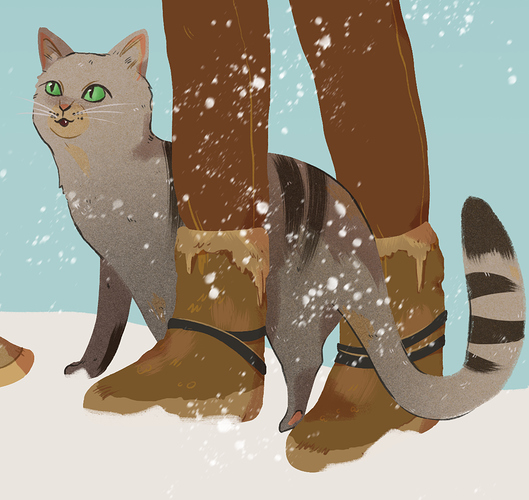It would be very nice to see/hear owls/wulfs at night, snakes (poisonous and non toxic) hiding in grass and attack your people - some get sick caused by the poison so you have to care about that and gather herbs to improve healing process. bears attacking your food storage would be nice to watch and the people have to work together to save the food storage or even hunt the bear and you get new ressources (food, leather, teeth for decoration, e.g. hunters whear them on a necklace or soemthing like that.
It would be nice that everyone is in way special, like yes, few sets of clothes, but as you meantioned, teeth for decoration, hunter who would kill bear would wear them as trophy
Hey guys, very much looking forwards to this.
So I was wondering: Whats the plan for Domestication, and how will it work in Gameplay terms? Are we looking at a technology that you have to “research” ala Age of Empires style, or will you have to go through, for lack of a better term, a set of quest objectives. If you have the latter idea (or even the former) will you only be able to domesticate animals you discover on the map?
Historically different animals where domesticated in different regions (Goats in the Middle East, Horses on the Ukrainian Steppe, etc) and where then spread by migration, trade and interactions between different cultures, so is this perhaps another way to gain access to domesticated animals that may or may not be present on a given map?
Regarding Russian Domesticated Red Fox Saw a program on this ; may have been nova or nature onPPS. The foxes changed apearence with floppy ears and variations their coats like domestic dogs,very interesting program
I’m all for cats, but they would probably not be too common.
If they do exist, remember they would be bigger.
Also, cats could be a nuisance for drying fish or foods left unattended.
(This fellow is a well fed European wild cat)
Developers mentioned pets so cant wait to have cat lover tribe that will grow to Egypt civ 
Well, you can start up a cat religion, like Bast! 
Not sure that European Wild Cat would appreciate the temperatures in Egypt, though lol
I was wondering about the animals behaviour. Will herds react like one group (like IRL) or each animals will live it own life. Moreover, will they avoid the tribe ? (it is not very realistic to have wild animals walking peacefully in your village). Finally, will day/night cycle impact animals behaviour ? (pretators and pack hunters come closer during the night).
Pets are one of the still hidden stretch goals in the indiegogo campaign, which is growing, but slowly. So pets are still far away.
Good points. They can also pull loads or a sades bag kind of thing.
Equestrianism
History of horse use:
Though there is controversy over the exact date horses were domesticated and when they were first ridden, the best estimate is that horses first were ridden approximately 3500 BC. Indirect evidence suggests that horses were ridden long before they were driven. There is some evidence that about 3,000 BC, near the Dnieper River and the Don River, people were using bits on horses, as a stallion that was buried there shows teeth wear consistent with using a bit.[3] However, the most unequivocal early archaeological evidence of equines put to working use was of horses being driven. Chariot burials about 2500 BC present the most direct hard evidence of horses used as working animals. In ancient times chariot warfare was followed by the use of war horses as light and heavy cavalry. The horse played an important role throughout human history all over the world, both in warfare and in peaceful pursuits such as transportation, trade and agriculture.
Source:
I’m currently working my way through David Anthony’s book “the Horse, the Wheel, and Language.” (a really good read for anyone who is interested in the Neolithic and Bronze age steppes by the way, if you can stand reading a lot about pots and obscure material cultures). The evidence he produces in favour of bit wear on Eneolithic steppe horse teeth is pretty convincing (Anthony also references a number of horses from several sites on the Steppe which exibit wear consistent with what experimental Archaeology produced using soft [aka non metallic] bits on modern horses). Certainly the amount of horse bones in Steppe sites prior to the Yamnaya Horizon indicates that horses where at the very least in the process of domestication before 3000 BC.
Really interesting to me are the Botai (horse riding also attested by horse molars showing bit wear from multiple sites) who appear to have ridden horses to hunt horses (as opposed to a lot of other steppe cultures who appear to have ridden horses to heard horses.
edit For the record “The Horse, the Wheel, and Language” is only tangentially about equestrianism, it is really about tracing the spread of PIE, but the domestication of the horse appears to have been rather important so Anthony devotes an entire chapter to research on the subject (and then of course the subject crops up on occasion in relation to specific sites and cultures).
Animal Companions is now one of the unlockable stretch goals on the Indiegogo campaign! And while it’s unlikely we’ll make it that far in only a week, here’s hoping we get to 100,000.
You all may be all about those dogs cats and bears … But how about deadly snakes? Deadly hippos? Deadly crocs? Spiders … No antidotes for venom… Or better yet what if our people get stung to death by bees???
You want realism? Well that is one way to teach people that the world back then was very… Very dangerous… No meds… No shots… No antidots
. you were … In a lot of trouble… if you got bit by anything that contained poison… Just throwing it out there…
Now that you mention it there were hippos in middle east at that time. It seems that 80% of the ivory object of this area was made in hippos ivory (which explain why there is no more hippos there ![]() )
)
Deadly spiders and bees seem a bit unlikely for temperate Eurasia. Bees are only a threat if you happen to be allergic and lethaly venomous spiders are rather rare in Europe and the Middle East.
Snakes, sue. Although lethally venomous ones are also not quite as plentyful in those areas as they are in Australia or the tropics.
I think the largest threat really originates from large vertebrate species here. So yeah, the crocs and hippos you mentioned, but also the wolves, bears, lions, hyenas and wild cattle. Especially “harmless” animals such as cattle shouldn’t be underestimated. Aurochsen and European Bison can easily maul a human. Probqably easier than a wolf ever could.
Regarding Poisonous bugs, animals and plants. Would it be possible for a tribe to learn the specific properties of these things to create resources for medicine or hunting?
Poisonous or Venomous?
Ah, venomous 
I’m sitting here with beeswax working on Neolithic crafts, and it occurs to me that bees are an Incredibly important animal to have in the game.
They provide honey and wax. Honey is used for medicine, food not to mention alcohol, and wax is used as a water sealant, medicine, fuel for clamshell lamps, and many other things.
Best of all, bees are easy to animate because you can simply use a single tiny sphere object or something like that to be a bee. Remember, Neolithic people would have had to kill the bee colony in order to get the honey and wax, so they should appear but then be destroyed upon harvesting.
2 pounds of beeswax I bought this morning for use in Neolithic crafts


